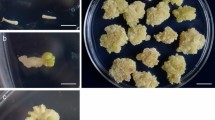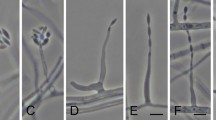Abstract
The effect of two stilbene compounds, pinosylvin and resveratrol, on the growth of several fungi was evaluated in plate tests. Wood decay tests were carried out with birch and aspen samples impregnated with the two stilbenes. In plate experiments, resveratrol had an enhancing effect on growth at concentrations where pinosylvin was already enough to prevent the growth of most fungi studied. Pinosylvin impregnated at 0.2% (w/w) concentration significantly reduced the decay caused by all fungi except Phellinus tremulae. In contrast, a resveratrol content of 0.8%, did not protect the wood from decay. A pinosylvin-synthase-encoding gene from Pinus sylvestris was transferred into aspen (Populus tremula) and two hybrid aspen clones (Populus tremula×tremuloides) by Agrobacterium tumefaciens-mediated transformation. Transgenic plants accumulated pinosylvin synthase-specific mRNA and showed stilbene synthase enzyme activity in vitro. Transgenic aspen line H4 showed increased resistance to Phellinus tremulae, while two hybrid aspen transformants decayed faster than the control trees. However, we were unable to detect the accumulation of stilbenes in the transgenic plantlets.



Similar content being viewed by others
References
Adrian M, Jeandet P, Veneau J, Weston L, Bessis R (1997) Biological activity of resveratrol, a stilbenic compound from grapevines, against Botrytis cinerea, the causal agent for gray mold. J Chem Ecol 23:1689–1702
Allina SM, Pri-Hadash A, Theilmann DA, Ellis BE, Douglas CJ (1998) 4-Coumarate:Coenzyme A ligase in hybrid poplar. Properties of native enzymes, cDNA cloning, and analysis of recombinant enzymes. Plant Physiol 116:743–754
Bala A, Kollmann A, Ducrot P-H, Majira A, Kerhoas L, Delorme R, Einhorn J (1999) Antifungal activity of resveratrol oligomers from Cyphostemma crotalarioides. Pestic Sci 55:197–218
Cerny A (1972) Phellinus tremulae (Bond.) Bond. et Borisov—a most serious fungal parasite of aspen trees. Acta Univ Agric Brno C41:131–149
Chang S, Puryear J, Cairney J (1993) A simple and efficient method for isolating RNA from pine trees. Plant Mol Biol Rep 11:113–116
Church GM, Gilbert W (1984) Genomic sequencing (DNA methylation/UV crosslinking/filter hybridization/immunoglobulin genes). Proc Natl Acad Sci USA 81:1991–1995
Coutos-Thevenot P, Poinssot B, Bonomelli A, Yean H, Breda C, Buffard D, Esnault R, Hain R, Boulay M (2001) In vitro tolerance to Botrytis cinerea of grapevine 41B rootstock in transgenic plants expressing the stilbene synthase Vst1 gene under the control of a pathogen-inducible PR 10 promoter. J Exp Bot 52:901–910
Ehlting J, Büttner D, Wang Q, Douglas CJ, Somssich IE, Kombrink E (1999) Three 4-coumarate:coenzyme A ligases in Arabidopsis thaliana represent two evolutionary divergent classes in angiosperms. Plant J 19:9–20
Erdtman H (1939) Tallkärnvedens extraktivämnen och deras inverkan på uppslutningen enligt sulfitmetoden. Sven Papperstidn 42:344–349
Erdtman H, Frank A, Lindstedt G (1951) Constituents of pine heartwood. XXVII. The content of pinosylvin phenols in Swedish pines. Sven Papperstidn 54:275–279
Fliegmann J, Schröder G, Schanz S, Britsch L, Schröder J (1992) Molecular analysis of chalcone and dihydropinosylvin synthase from Scots pine (Pinus sylvestris), and differential regulation of these and related enzyme activities in stressed plants. Plant Mol Biol 18:489–503
Frykholm KO (1945) Bacteriological studies of pinosylvine, its monomethyl and dimethyl ethers, and toxicologic studies of pinosylvine. Nature 155:454–455
Gehlert R, Schöppner A, Kindl H (1990) Stilbene synthase from seedlings of Pinus sylvestris: purification and induction in response to fungal infection. Mol Plant Microbe Interact 3:444–449
Grand C, Boudet A, Boudet AM (1983) Isoenzymes of hydroxycinnamate:CoA ligase from poplar stems properties and tissue distribution. Planta 158:225–229
Hahlbrock K, Scheel D (1989) Physiology and molecular biology of phenylpropanoid metabolism. Annu Rev Plant Physiol Plant Mol Biol 40:347–369
Hain R, Grimmig B (2000) Modification of plant secondary metabolism by genetic engineering. In: Verpoorte R, Alfermann AW (eds) Metabolic engineering of plant secondary metabolism. Kluwer, Dordrecht, pp 217–231
Hain R, Bieseler B, Kindl H, Schröder G, Stöcker R (1990) Expression of a stilbene synthase gene in Nicotiana tabacum results in synthesis of the phytoalexin resveratrol. Plant Mol Biol 15:325–335
Hain R, Reif HJ, Langebartels R, Schreier PH, Stöcker RH, Thomzik JE, Stenzel K (1992) Foreign phytoalexin expression in plants results in increased disease resistance. In: Proceedings of Brighton crop protection conference—pests and diseases. British Crop Protection Council, Alton, UK, pp 757–766
Hain R, Reif H-J, Krause E, Langbartels R, Kindl H, Vornam B, Wiese W, Schelzer E, Schreier PH, Stöcker RH, Stenzel K (1993) Disease resistance results from foreign phytoalexin expression in a novel plant. Nature 361:153–156
Hart J (1981) Role of phytostilbenes in decay and disease resistance. Annu Rev Phytopathol 19:437–458
Hart J, Hillis W (1974) Inhibition of wood-rotting fungi by stilbenes and other polyphenols in Eucalyptus sideroxylon. Phytopathology 64:939–948
Henriks M-L, Ekman R, von Weissenberg K (1979) Bioassay of some resin and fatty acids with Fomes annosus. Acta Acad Abo Ser B 34:9
Hiorth J (1965) The phenoloxidase and peroxidase activities of two culture types of Phellinus tremulae (Bond.) Bond. et Boriss. Medd Nor Skogforsöksves 20:249–272
Hipskind JD, Paiva NL (1998) Phytoalexin engineering in alfalfa: introduction of a resveratrol synthase from Arachis hypogaea. In: 7th International Congress of Plant Pathology, Abstracts vol 2. 9–16 August 1998, Edinburgh, Scotland
Hoos G, Blaich R (1990) Influence of resveratrol on germination of conidia and mycelial growth of Botrytis cinerea and Phomopsis viticola. J Phytopathol 129:102–110
Hopp H (1936) Appearance of Fomes igniarius in culture. Phytopathology 26:915–917
Kobayashi S, Ding CK, Nakamura Y, Nakajima I, Matsumoto R (2000) Kiwifruits (Actinia deliciosa) transformed with a Vitis stilbene synthase gene produce piceid (resveratrol-glucoside). Plant Cell Rep 19:904–910
Leckband G, Lörz H (1998) Transformation and expression of a stilbene synthase gene of Vitis vinifera L. in barley and wheat for increased fungal resistance. Theor Appl Genet 96:1004–1012
Lee D, Douglas CJ (1996) Two divergent members of a tobacco 4-coumarate:Coenzyme A ligase (4CL) gene family. Plant Physiol 112:193–205
Lindstedt G (1951) Constituents of pine heartwood. XXV. Acta Chem Scand 5:129–138
Lindstedt G, Misiorny A (1951) Constituents of pine heartwood. XXVI. Acta Chem Scand 5:121–128
Lloyd G, McCown B (1980) Commercially feasible micropropagation of mountain laurel, Kalmia latifolia, by use of shoot-tip culture. Int Plant Propagator’s Soc Proc 30:421–427
Lofty S, Fleuriet A, Ramos T, Macheix J-J (1989) Biosynthesis of phenolic compounds in Vitis vinifera cell suspension cultures: study on hydroxycinnamoyl CoA-ligase. Plant Cell Rep 8:93–96
Loman A (1970) Bioassays of fungi isolated from Pinus contorta var. latifolia with pinosylvin, pinosylvinmonomethyl ether, pinobanksin, and pinocembrin. Can J Bot 48:1303–1308
Murashige T, Skoog F (1962) A revised medium for rapid growth and bio assays with tobacco cultures. Physiol Plant 15:473–497
Niemelä T (1974) On fennoscandian polypores. III. Phellinus tremulae (Bond.) Bond. & Borisov. Ann Bot Fennici 11:202–215
Pappinen A, Degefu Y, Syrjälä L, Keinonen K, von Weissenberg K (2002) Transgenic silver birch (Betula pendula) expressing sugarbeet chitinase 4 shows enhanced resistance to Pyrenopeziza betulicola. Plant Cell Rep 20:1046–1051
Paul B, Chereyathmanjiyil A, Masih I, Chapuis L, Benoît A (1998) Biological control of Botrytis cinerea causing grey mould disease of grapevine and elicitation of stilbene phytoalexin (resveratrol) by a soil bacterium. FEMS Microbiol Lett 165:65–70
Rennerfelt E (1943) Die toxizität der Phenolischen Inhaltsstoffe des Kiefernkernholzes gegenüber einigen Fäulnispilzen. Sven Bot Tidskr 37:83–93
Rennerfelt E (1945) The influence of the phenolic compounds in the heartwood of Scots pine (Pinus silvestris L.) on the growth of some decay fungi in nutrient solution. Sven Bot Tidskr 39:311–318
Rennerfelt E, Nacht G (1955) The fungicidal activity of some constituents from heartwood of conifers. Sven Bot Tidskr 49:419–432
Rosemann D, Heller W, Sandermann H (1991) Biochemical plant responses to ozone, II. Induction of stilbene biosynthesis in Scots pine (Pinus sylvestris L.) seedlings. Plant Physiol 97:1280–1286
Sarig P, Zutkhi Y, Monjauze A, Lisker N, Ben-Arie R (1997) Phytoalexin elicitation in grape berries and their susceptibility to Rhizopus stolonifer. Physiol Mol Plant Pathol 50:337–347
Schwekendiek A, Pfeffer G, Kindl H (1992) Pine stilbene synthase cDNA, a tool for probing environmental stress. FEBS Lett 301:41–44
Serazetdnova L, Lörz H (2002) Poster presentation at 1st EPSO Conference: networks in plant biology. 27–31 October 2002, Brunnen, Switzerland
Shin N-H, Ryu S, Choi E, Kang S-H, Chang I-M, Min K, Kim Y (1998) Oxyresveratrol as the potent inhibitor on dopa oxidase activity of mushroom tyrosinase. Biochem Biophys Res Commun 243:801–803
Skinnider L, Stoessl A (1986) The effect of the phytoalexins, lubimin, (−) maackiain, pinosylvin, and the related compounds dehydroloroglossol and hordatine M on human lymphoblastoid cell lines. Experientia 41:568–570
Stark-Lorenzen P, Nelke B, Hänler G, Muhlbach HP, Thomzik JE (1997) Transfer of a grapevine stilbene synthase gene to rice (Oryza sativa L.) Plant Cell Rep 16:668–673
Thomzik JE (1993) Transformation in oilseed rape (Brassica napus L.). In: Bajaj YPS (ed) Biotechnology in agriculture and forestry, vol. 23. Plant protoplasts and genetic engineering IV. Springer, Berlin Heidelberg New York, pp 170–182
Thomzik J, Stenzel K, Stöcker R, Schreier P, Hain R, Stahl D (1997) Synthesis of a grapevine phytoalexin in transgenic tomatoes (Lycopersicon esculentum Mill.) conditions resistance against Phytophthora infestans. Physiol Mol Plant Pathol 51:265–278
Tian W-Z, Ding L, Cao S-Y, Dai S-H, Ye S-Q, Li L-C (1998) Rice transformation with a phytoalexin gene and bioassay of the transgenic plants. Acta Bot Sin 40:803–808
Venäläinen M, Harju AM, Kainulainen P, Viitanen H, Nikulainen H (2003a) Variation in the decay resistance and its relationship with other wood characteristics in old Scots pines. Ann For Sci 60:409–417
Venäläinen M, Harju AM, Saranpää P, Kainulainen P, Tiitta M, Velling P (2003b) The concentration of phenolics in brown-rot decay resistant and susceptible Scots pine heartwood. Wood Sci Technol (in press)
Voo KS, Whetten RW, O’Malley DM, Sederoff RR (1995) 4-Coumarate:Coenzyme A ligase from loblolly pine xylem. Isolation, characterization, and complementary DNA cloning. Plant Physiol 108:85–97
Weisshaar B, Jenkins GI (1998) Phenylpropanoid biosynthesis and its regulation. Curr Opin Plant Biol 1:251–257
Winkel-Shirley B (1999) Evidence for enzyme complexes in the phenylpropanoid and flavonoid pathways. Physiol Plant 107:142–149
Zhang X-H, Chiang VL (1997) Molecular cloning of 4-coumarate:coenzyme A ligase in loblolly pine and the roles of this enzyme in the biosynthesis of lignin in compression wood. Plant Physiol 113:65–74
Acknowledgements
TEKES, Kordelin foundation, Metsämiesten säätiö foundation, and the Ministry of Education supported this work financially. We wish to thank Dr. Joachim Schröder for his gift of plasmid pKK233-2 containing the pine stilbene synthase gene, Dr. Carlos Navarro for the statistical analysis of the transgenic trees, and Farzad Safavi for revising the language. We are also grateful to Tuula Laine and Lahja Pesonen for their excellent technical assistance and to all those who provided pure cultures of decay fungi (Table 1).
Author information
Authors and Affiliations
Corresponding author
Additional information
Communicated by P. Debergh
Rights and permissions
About this article
Cite this article
Seppänen, SK., Syrjälä, L., von Weissenberg, K. et al. Antifungal activity of stilbenes in in vitro bioassays and in transgenic Populus expressing a gene encoding pinosylvin synthase. Plant Cell Rep 22, 584–593 (2004). https://doi.org/10.1007/s00299-003-0728-0
Received:
Revised:
Accepted:
Published:
Issue Date:
DOI: https://doi.org/10.1007/s00299-003-0728-0




